The Mike Toole Show
Son of a Gunbuster
by Michael Toole,
If you're enough of a nerd for Evangelion minutae, you may have noticed something interesting at the beginning of October: the mention of Gainax in the manga's copyright data vanished. This wasn't the first time something like that had happened, though; various Evangelion projects had, previously, been divvied up in strange ways between Gainax and Khara, the company that Hideaki Anno created to get cracking on the Rebuild films. But then, on Halloween no less, the perennial mention of Gainax at the bottom of the official Evangelion website also vanished. It hasn't come back.
A few weeks after that, Studio Khara made an exciting announcement: Neon Genesis Evangelion TV was finally coming to blu-ray! Yes, these two events—Evangelion disappearing from Gainax's books and the TV series getting the green light for bluray—are linked. Gainax have had an interesting 2014, haven't they? It's not like they're decrepit and circling the drain, though; they kicked out Magica Wars this year, and still have projects planned for the future. But once upon a time, they were a pretty special outfit, a company full of true otaku where amazing ideas bubbled to the surface in the form of exciting new animation. One of their first and most sustained successes was an OVA series called Aim for the Top! Gunbuster.

I've had Gunbuster on the brain for a few weeks, because I went to the movies and saw Interstellar, and both works deal with the hard science fiction (and real science) idea of time dilation. I'm in good company in comparing the two, actually; around the same time I caught the movie, Metal Gear creator Hideo Kojima tweeted a recommendation for fans of Interstellar to seek out Gunbuster. You can still take his advice, too—Gunbuster's not been in print for a long time, but Amazon currently only wants about forty bucks for the handsome complete DVD set, which is probably a testament to how grossly Bandai Visual USA overmanufactured the thing.
If you look at the broader context of Gainax's history up until the point of Gunbuster's release in 1988, you can see that the creation of something like it was inevitable. As he glibly put it in his 2002 remembrance The Notenki Memoirs, former Gainax GM Yasuhiro Takeda said that, “the whole future was sci-fi,” and Gunbuster, on its face, feels like the ultimate application of that ideal. Gunbuster itself is the creation of a bona fide all-star squad made up of both Gainax regulars (director Hideaki Anno, creator/writer Toshio Okada, character designer Yoshiyuki Sadamoto) and accomplished creative staff like Kohei Tanaka (music), Haruhiko Mikimoto (original character design), and Kazutaka Miyatake (mecha design). At its heart, it's a complex, weirdly flavorful mixture of exhilarating sports anime and challenging, far-reaching interstellar science fiction.

The genius of the director, Mr. Anno, is in the way he tips his hand gradually. The first episode of Gunbuster doesn't really feel like thoughtful science fiction at all—it plays more like parody, as space academy recruit Noriko Takaya struggles to master the RX-7 combat suit, all while pining after school idol Kazumi Amano. This training involves lots of silly shots of mecha suits jogging and doing calisthenics. By the time the viewer meets the episode's huge-foreheaded bully and hard-faced coach, all of the sports cliches are in play, and the story spools out like tennis anime classic Aim for the Ace in fast-forward. Despite her struggles with the RX-7 and her troubled past, Noriko passes the test and joins Kazumi in space! Episode two opens with battle scenes reminiscent of Space Battleship Yamato (it isn't long before, just as in Yamato, the flagship's third bridge is destroyed), a commercial spaceflight scene that brings 2001: A Space Odyssey to mind, and a great shot of the space station, a nice, logical-looking Stanford Torus. Within a few minutes, Anno and company go from Attack no. 1 to 2001 Nights, and they do it gracefully.
Episode two continues the weird ballet, juxtaposing an infamous low-G bathing scene with a genuine relativistic nightmare. The show pulls the old trick of introducing a secondary character who's just as cool as the heroines in the pilot prodigy Jung Freud (she hails from the Soviet Union! Remember when that was a thing?), but then, during a lightspeed exercise that's only supposed to incur a time debt of a few weeks for Noriko and Kazumi, they bump into the capital ship of Noriko's father, who perished in battle—a battle that was lost nearly a decade ago. Adrift in hyperspace, only two days have passed for the half-ruined battleship since it was sunk. Noriko has to get aboard, has to know what happened, but it could cost her months or years away from the rest of the world.
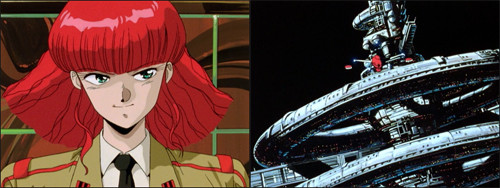
In this way, Gunbuster keeps the viewer on their toes, alternately dishing up fanservice and existential terror, hot mecha battles and a rare view of man's place in the cosmos. Noriko and Kazumi eventually learn that their RX-7 units are just training wheels for a far more formidable weapon, the Gunbuster. There's fresh horror when Noriko befriends a doomed pilot, and when Earth's command discovers that the aliens they fight might not be a calculating competing civilization, but simply agents of the galaxy's immune system, impersonally aiming to wipe out a humanity that only serves itself. Noriko herself is awash in paralyzing anxiety—sure, she might be the one pilot with the raw talent to prevail, but not only is she facing near-certain death, every lightspeed hop across space is carrying her old life away from her. Her school roommate grows up and has kids. Time becomes an enemy as great as the space monsters. When she falters, her tactical commander, the man she affectionately calls “Coach,” grits his teeth. “I won't bench her,” he barks.
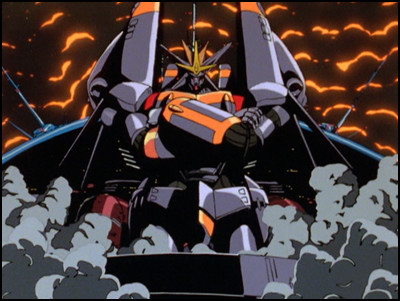
The balance of Gunbuster is full of goofy references, and endlessly clever. We notice that the ships have a payload of photon torpedoes, and the penultimate episode shares the title of Robert Heinlein's popular novel Time Enough For Love. When the iconic pounding drums start and the Gunbuster, arms fearsomely crossed, is finally revealed (remember, Koichi Ohata of M.D. Geist fame designed the thing; maybe Geist was never really bad, it was simply too dangerous), we learn that, like Getter Robo, it's a gattai (combining) robot. My favorite gag? Episode 3 opens with a recap of previous events that, rather than break down the story, clinically explains the scientific principles behind the events. Remember, the space battle that kicks off Gunbuster actually takes place in 2015. That's just around the corner!
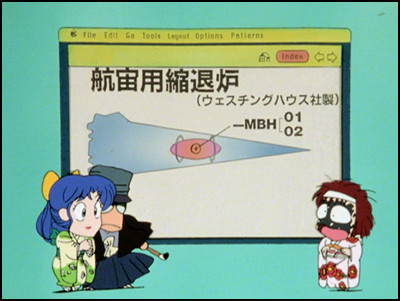
Gunbuster is bookended with short gag episodes called “science lessons,” which attempt to explain and contextualize the scientific concepts used in the series. These are hosted by chibi versions of Noriko and Kazumi, who dutifully guide the viewer through a Hypercard stack, which both dates the material and reminds the viewer how much Hypercard still looks kinda like a modern web browser. Interestingly, a couple of these episodes were newly-produced for a late-90s reissue of Gunbuster on laserdisc. Even more interestingly, one of them is the directorial debut of a rising talent named Kazuya Tsurumaki. Even more interesting still, Tsurumaki would eventually helm Aim for the Top 2: Diebuster, Gainax's 20th-anniversary sequel to Gunbuster.
In these parts, we know the 2004 Aim for the Top 2 as Gunbuster 2, which is sort of a peculiar retitling. It's understandable why Bandai Visual USA opted to do it, since it establishes a concrete link between the shows that otherwise wouldn't necessarily be obvious (even putting the time difference aside, they look very different, and the first Gunbuster has never been commonly known by its alternate title, Aim for the Top!, over here), but the show is never referred to as Gunbuster 2 anywhere in the Japanese production extras. It's kind of like deciding to change the title of The Empire Strikes Back to Star Wars 2, just to be absolutely certain that people know they're related.

The original Gunbuster opened with a fresh-faced girl in track and field clothes. Gunbuster 2 opens with a fresh-faced girl in a maid/waitress outfit. There's your sign of the times. There's no trace or mention of the heroes of the original, or the massive alien invasion they fought off to save humankind. The girl, Nono, wants to be a space pilot. She gets into a little trouble at her diner job, and an actual pilot, a grim-faced young lady, pulls a weird button off of her forehead, causing a hulking Buster Machine to eye-poppingly leap right out of her shadow… and there's your link to Gunbuster right there.
Curiously, Gunbuster 2 seldom really goes farther with its callbacks to the original than the mere existence of Buster Machines (while the frequently-seen Dix-Neuf is a fantastic mech, we never get to see the original Gunbuster, or even the later mass-production “Sizzler” Gunbusters) and the presence of invading alien monsters. This time, there are some 31 Buster Machines to defend against the alien menace, piloted by adepts with the unfortunate moniker of “Topless.” After Nono rips open her shirt and performs a flying Inazuma kick on the bad guys (probably the single most obvious reference to the original), she proudly proclaims, “I became a Topless, too!” Yep, you sure did, lady.
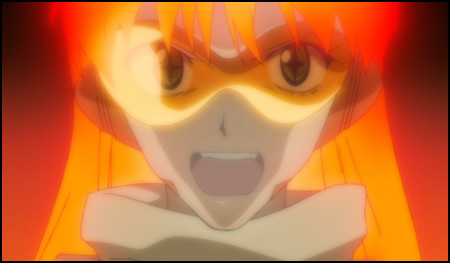
There's considerable staff crossover between the original Gunbuster and Gunbuster 2—Shinji Higuchi, who drew the storyboards for the entire original series, returns for episode 1 of the sequel, Kohei Tanaka brings back the iconic Gunbuster theme song, and Yoshiyuki Sadamoto once again supplies character designs, though this time he's not building on the great Haruhiko Mikimoto's work. But with Tsurumaki directing and getting scripts from Yoji Enokido, Gunbuster 2 feels a lot more like the successor to FLCL than the successor to Gunbuster. Its themes and narrative arc slowly swing back towards Aim for the Top!, but visually, the series hews towards FLCL, with angular, boxy mecha, bizarre art direction, and one girl who rides around on a scooter, wearing a big scarf.
What's next? Well, there's one character who correctly uses the term “moe” (yep, this show's pretty modern), a younger, dumber version of Jung Freud who issues the exact same “switch off your marker signal and fight me!” challenge, a satellite shaped like a pair of eyeglasses, and a whole retinue of Topless pilots, who gradually age out of their profession, Peter Pan-style. Grown-ups, as usual, are not to be trusted, an idea reinforced by Tsurumaki in a supplementary interview. The Buster Machines themselves are unique and have loads of character, and rather than being the original's “gattai” machines, these are “henshin” machines with elaborate power-up sequences. Hey, one of those Topless pilots is Steve Brule!
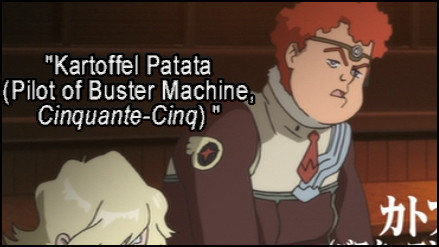
Given the other hooks, I'm a little disappointed that Gunbuster 2 doesn't feature a cameo by a translator/importer friendly to Gainax, like the original series did. Why didn't the heroines of Gunbuster 2 eventually get some help from a dashing young man named House Michael? But despite the lack of an obvious narrative arc and the grandeur of its predecessor, I think that viewing Gunbuster 2 is still absolutely fundamental to understanding Gainax. Along with Tsurumaki's “never trust adults” conceit, this is a series that is much more about the will to do good things and the need for heroes. In the original, Noriko is driven by duty and desperation; here, Nono wants to be a brave space pilot. Her dour friend and partner, Lal'C, observes, “Even as small children, when someone is distressed and clearly asks for help, there's a natural urge to provide it.”
Gunbuster 2 eventually links up with the original in a few delightful ways, but they're still pretty astonishingly different. I think that Yutaka Izubuchi, who interviewed Tsurumaki and scribe Enokido, puts it best: both Gunbuster and Gunbuster 2 are about taking the things that you loved best as a child and putting them to paper. Anno and company grew up on high-kicking tokusatsu heroes, sports anime, and award-winning science fiction. Tsurumaki, who came along a few years later, grew up with more colorful, friendly heroes, antagonistic adults, and less strictly realistic SF. Still, both works have that sci-fi edge; while Gunbuster's time dilation draws comparisons to Joe Haldeman's classic The Forever War, the discovery of millennia-old relics in space in Gunbuster 2 evokes James P. Hogan's Inherit the Stars.
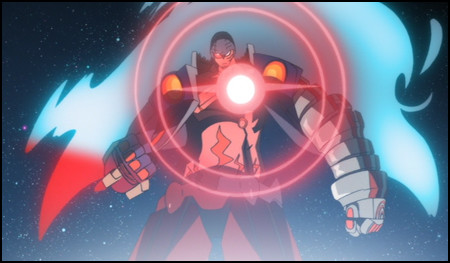
Still, in comparing these two cornerstones of Gainax's oeuvre, it's Gunbuster that feels more tangible and authentic. In creating the series, Anno, Okada and company were reaching past what anime already was, trying to create something that would both satisfy their otaku desires and challenge their minds. That's a delicate balance to strike, but they pulled it off. The sequel, with its visions of maid outfits, megane-satellites, and hyperactive action sequences, seems like something that lives and breathes in the otaku present day of 2004. At any rate, each one is a distillation of Gainax then versus Gainax now; the only things that have remained over the years are the jokes about tax avoision.
It's kind of weird to have Gunbuster 2 still in print (courtesy of a recent reissue by Discotek, though the original Bandai Visual USA release isn't hard to track down) but the original off the map, so to speak. To me, it's even weirder that Gunbuster never got an English dub. I understand that the music and effects track is lost, making a dub cost-prohibitive, but reconstructed dubs aren't unheard of, are they? It must be really challenging to recreate the music and effects track, because I can't find evidence that Gunbuster has been dubbed in any language besides Japanese. What's up with that?
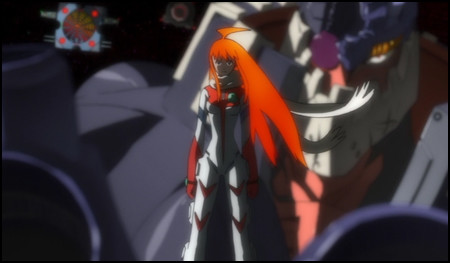
When I first saw Gunbuster in the mid-1990s, it was sold to me as a masterpiece. Coming at it with wiser and more cynical eyes… yeah, even now, it holds up pretty well, despite the spinning computer tape reels and corded telephones in the background. It's still so different, both in its mixture of soft and hard storytelling and its spellbinding ending, told in letterboxed monochrome. Gunbuster 2’s a pretty worthy follow-up, but it feels incomplete somehow. I kind of hope Gainax can get back to it, eventually; Enokido has joked that it's only the second act of a story spanning 4.8 billion years! Gainax, for that part, are pushing ahead on Uru in Blue, a long-discussed and little-seen sequel, of sorts, to Royal Space Force. This is not the first time the company has put all their eggs in one basket, but it is the first time that basket is a long-stalled follow-up to their decades-old debut film. But as long as they aim for the top, things should turn out all right.
discuss this in the forum (46 posts) |